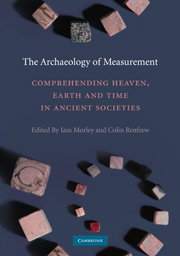Book contents
- Frontmatter
- Contents
- List of figures and tables
- List of contributors
- Acknowledgements
- The Archaeology of Measurement
- Introduction: Measure: Towards the construction of our world
- SECTION I NUMBER: COUNTING, MATHEMATICS AND MEASURE
- SECTION II MATERIALISING THE ECONOMY
- 7 Measuring by weight in the Late Bronze Age Aegean: The people behind the measuring tools
- 8 The concept of weighing during the Bronze Age in the Aegean, the Near East and Europe
- 9 Measuring the Harappan world: Insights into the Indus order and cosmology
- SECTION III DIMENSIONS AND BELIEF
- SECTION IV CALENDAR AND COSMOLOGY
- SECTION V THE SPIRITUALITY OF MEASURE
- Index
- References
8 - The concept of weighing during the Bronze Age in the Aegean, the Near East and Europe
Published online by Cambridge University Press: 05 June 2012
- Frontmatter
- Contents
- List of figures and tables
- List of contributors
- Acknowledgements
- The Archaeology of Measurement
- Introduction: Measure: Towards the construction of our world
- SECTION I NUMBER: COUNTING, MATHEMATICS AND MEASURE
- SECTION II MATERIALISING THE ECONOMY
- 7 Measuring by weight in the Late Bronze Age Aegean: The people behind the measuring tools
- 8 The concept of weighing during the Bronze Age in the Aegean, the Near East and Europe
- 9 Measuring the Harappan world: Insights into the Indus order and cosmology
- SECTION III DIMENSIONS AND BELIEF
- SECTION IV CALENDAR AND COSMOLOGY
- SECTION V THE SPIRITUALITY OF MEASURE
- Index
- References
Summary
The concepts applied in prehistoric societies and early civilisations to quantify the number of things and their length (including speed and distance), volume and weight offer an important and direct understanding of the minds of the ancient people, the organisation of their societies and their contacts with the neighbouring cultures. However, analysing early quantification has never played a major role in archaeology. This is partly a result of the difficult evidence one is facing: the detection of ancient measurement in the archaeological record is surely one of the greatest difficulties to be overcome in the study of early quantification. This also holds true for early weight metrology. Nevertheless, the importance of this topic and its relevance for early societies have been acknowledged by more and more scholars in recent years. More detailed empirical work is needed before the establishment of broad theories and reconstructions becomes possible. For example, there are still many questions about the spread and adoption of the various weighing systems used in the eastern Mediterranean, in the Near and Middle East and in Europe during the Bronze and Iron Ages. It is still a matter of debate as to the earliest date from which weights were known and used in some parts of the world.
- Type
- Chapter
- Information
- The Archaeology of MeasurementComprehending Heaven, Earth and Time in Ancient Societies, pp. 88 - 105Publisher: Cambridge University PressPrint publication year: 2010
References
- 15
- Cited by



